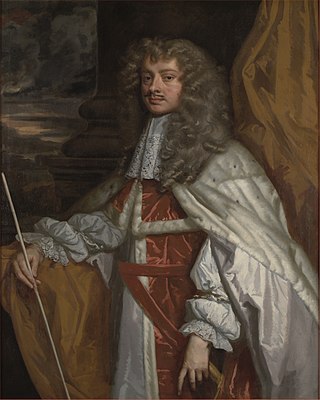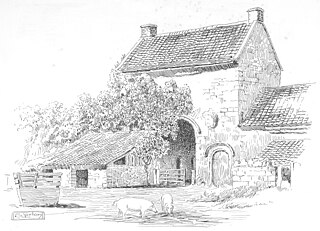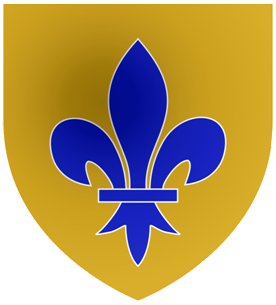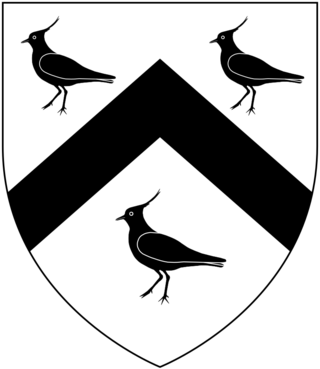
Thomas Clifford, 1st Baron Clifford of Chudleigh was an English statesman who sat in the House of Commons from 1660 to 1672 when he was created Baron Clifford. He was one of five leading politicians who formed the Cabal ministry between 1668 and 1674 in the reign of Charles II.
The Paston Letters are a collection of correspondence between members of the Paston family of Norfolk gentry and others connected with them in England between the years 1422 and 1509. The collection also includes state papers and other important documents.

Little Sodbury is a village and former civil parish, now in the parish of Horton, in the South Gloucestershire district, in the ceremonial county of Gloucestershire, England. It is located between Chipping Sodbury, to the west, Old Sodbury to the south, Badminton, and the A46 road to the east and Horton and Hawkesbury Upton, to the north. In 2011 the parish had a population of 113. On 1 April 2023 the parish was abolished and merged with Horton.

Olveston is a small village and larger parish in South Gloucestershire, England. The parish comprises the villages of Olveston and Tockington, and the hamlets of Old Down, Ingst and Awkley. The civil parish population at the 2011 census was 2,033. Alveston became a separate church parish in 1846. The district has been inhabited since the Stone Age, and the salt marshes that made up almost half of the parish, were progressively drained in Roman and Saxon times. A sea wall was constructed at the same time to prevent flooding from the nearby estuary of the River Severn.

Horton is a village and civil parish on the Cotswold Edge, in the South Gloucestershire district, in the ceremonial county of Gloucestershire, England. It is about 2+1⁄2 miles (4.0 km) north of Chipping Sodbury. The nearest settlement is Little Sodbury, about 1+1⁄2 miles (2.4 km) away; Hawkesbury Upton and Dunkirk are both 2+1⁄2 miles (4.0 km) miles away. It is a linear settlement built on the slopes of a steep hill. In 2011 the parish had a population of 355. On 1 April 2023 the parish of Little Sodbury was merged with Horton.

Sir Thomas Parr of Kendal in Westmorland, England, was a courtier and is best known as the father of Queen Catherine Parr, the sixth and final wife of King Henry VIII.
Sir William Yelverton KB was a judge in Norfolk, England and twice a member of parliament for Great Yarmouth, Norfolk.

Sir William Portman, 6th Baronet FRS was an English politician who sat in the House of Commons between 1661 and 1690.

Sir Maurice Denys (1516–1563) of Siston Court, near Bristol, Gloucestershire, and of St John's Street, Clerkenwell, Middlesex, was an English lawyer and property speculator during the Dissolution of the Monasteries, at which time he served as a "powerful figure at the Court of Augmentations". He served as a Member of Parliament for Malmesbury in Wiltshire and as Treasurer of Calais. He was the builder of Siston Court in Gloucestershire, which survives largely unaltered since his time. His excessive speculation and borrowing caused the ruination of the Siston branch of the Denys family.

Sir William Denys of Dyrham, Gloucestershire, was a courtier of King Henry VIII and High Sheriff of Gloucestershire in 1518 and 1526. The surname is sometimes transcribed as Dennis.
William Haute (1390–1462) of Bishopsbourne, Kent, was an English politician.
Sir Edmund Rous, of Dunwich, Suffolk, was an English landowner, magistrate, MP and Vice-Treasurer of Ireland.
Thomas Gawdy, of Shotesham and Redenhall, Norfolk, was Serjeant-at-law, an English barrister, Recorder, and member of parliament.
Nicholas Mynn, of Little Walsingham, Norfolk, was an English politician.

The Manor of Molland was a medieval manor in North Devon, England. It was largely co-terminous with the existing parish of Molland, in which is situated the village of Molland. More accurately it consisted from the earliest times of two separate manors, held from separate overlords, later known as Molland-Bottreaux and Molland-Champson.
Richard Lestrange of Hunstanton and King's Lynn, Norfolk; later of Kilkenny, Ireland, was an English politician.

John Twynyho of Cirencester, Bristol and Lechlade, all in Gloucestershire, was a lawyer and wealthy wool merchant who served as Recorder of Bristol, as a Member of Parliament for Bristol in Gloucestershire in 1472-5 and in 1484 and for the prestigious county seat Gloucestershire in 1476. In 1478 he was Attorney General to Lord Edward (the future King Edward V, eldest son and heir of King Edward IV.
Robert Whittington was the member of Parliament for the constituency of Gloucestershire for multiple parliaments from November 1384 to April 1414.
Thomas Thursby (1487–1543) of Ashwicken was a notorious land encloser in Norfolk in the 1510s–1540s.

Sir Robert Radcliffe or Radclyffe was an English landowner.


















